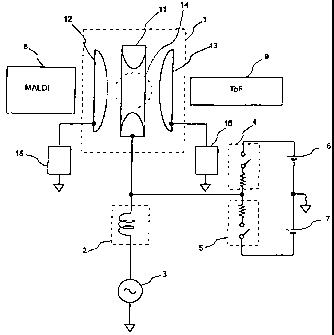Some of the information on this Web page has been provided by external sources. The Government of Canada is not responsible for the accuracy, reliability or currency of the information supplied by external sources. Users wishing to rely upon this information should consult directly with the source of the information. Content provided by external sources is not subject to official languages, privacy and accessibility requirements.
Any discrepancies in the text and image of the Claims and Abstract are due to differing posting times. Text of the Claims and Abstract are posted:
| (12) Patent: | (11) CA 2355193 |
|---|---|
| (54) English Title: | METHOD OF FAST START AND/OR FAST TERMINATION OF A RADIO FREQUENCY RESONATOR |
| (54) French Title: | PROCEDE DE DEMARRAGE ET/OU TERMINAISON RAPIDES D'UN RESONATEUR A FREQUENCES RADIOELECTRIQUES |
| Status: | Term Expired - Post Grant Beyond Limit |
| (51) International Patent Classification (IPC): |
|
|---|---|
| (72) Inventors : |
|
| (73) Owners : |
|
| (71) Applicants : |
|
| (74) Agent: | SMART & BIGGAR LP |
| (74) Associate agent: | |
| (45) Issued: | 2006-10-17 |
| (86) PCT Filing Date: | 1998-12-21 |
| (87) Open to Public Inspection: | 2000-06-29 |
| Examination requested: | 2002-11-18 |
| Availability of licence: | N/A |
| Dedicated to the Public: | N/A |
| (25) Language of filing: | English |
| Patent Cooperation Treaty (PCT): | Yes |
|---|---|
| (86) PCT Filing Number: | PCT/GB1998/003856 |
| (87) International Publication Number: | WO 2000038312 |
| (85) National Entry: | 2001-06-14 |
| (30) Application Priority Data: | None |
|---|
The invention aims to provide a method of fast start of an RF resonator and/or
fast
termination of the resonator to achieve a high efficiency of ion trapping from
the
MALDI ion source and/or effective extraction of the ions into a time-of flight
mass
spectrometer. The resonator has a coil (2), a capacitor (1) and two switches
with
internal resistance (4, 5). One end of the switches is connected to a junction
of the
coil (2) and the capacitor (1) where a RF voltage is provided, and another end
of
each switch is connected to high voltage power supplies with opposite
polarities (6,
7). The method comprises: closing one of the switches for a short period of
time for
fast start of the RF resonator, and/or closing both switches for a while for
fast
termination of the RF resonator.
L'invention concerne un procédé de démarrage et/ou terminaison rapides d'un résonateur à fréquences radioélectriques, lequel présente une bobine (2), un condensateur (1) ainsi que deux commutateurs dotés d'une résistance intérieure (4, 5). Une extrémité des commutateurs est connectée à une jonction de la bobine (2) et du condensateur (1) à l'endroit de fourniture d'une tension aux fréquences radioélectriques, l'autre extrémité de chaque commutateur étant connectée à des alimentations de puissance haute tension présentant des polarités opposées (6, 7). Le procédé de l'invention consiste à fermer l'un des commutateurs pendant une courte période, pour permettre le démarrage rapide du résonateur à fréquences radioélectriques, et/ou fermer les deux commutateurs pendant un moment pour permettre une terminaison rapide dudit résonateur.
Note: Claims are shown in the official language in which they were submitted.
Note: Descriptions are shown in the official language in which they were submitted.

2024-08-01:As part of the Next Generation Patents (NGP) transition, the Canadian Patents Database (CPD) now contains a more detailed Event History, which replicates the Event Log of our new back-office solution.
Please note that "Inactive:" events refers to events no longer in use in our new back-office solution.
For a clearer understanding of the status of the application/patent presented on this page, the site Disclaimer , as well as the definitions for Patent , Event History , Maintenance Fee and Payment History should be consulted.
| Description | Date |
|---|---|
| Inactive: Expired (new Act pat) | 2018-12-21 |
| Grant by Issuance | 2006-10-17 |
| Inactive: Cover page published | 2006-10-16 |
| Pre-grant | 2006-08-02 |
| Inactive: Final fee received | 2006-08-02 |
| Inactive: IPC from MCD | 2006-03-12 |
| Notice of Allowance is Issued | 2006-02-02 |
| Letter Sent | 2006-02-02 |
| Notice of Allowance is Issued | 2006-02-02 |
| Inactive: IPC assigned | 2006-01-31 |
| Inactive: Approved for allowance (AFA) | 2006-01-23 |
| Amendment Received - Voluntary Amendment | 2005-05-24 |
| Inactive: S.30(2) Rules - Examiner requisition | 2004-11-22 |
| Inactive: IPRP received | 2004-11-04 |
| Amendment Received - Voluntary Amendment | 2003-05-20 |
| Letter Sent | 2002-12-18 |
| Request for Examination Requirements Determined Compliant | 2002-11-18 |
| All Requirements for Examination Determined Compliant | 2002-11-18 |
| Request for Examination Received | 2002-11-18 |
| Letter Sent | 2001-11-13 |
| Inactive: Cover page published | 2001-10-17 |
| Inactive: Single transfer | 2001-10-10 |
| Inactive: First IPC assigned | 2001-09-25 |
| Inactive: Courtesy letter - Evidence | 2001-09-11 |
| Inactive: Notice - National entry - No RFE | 2001-09-05 |
| Application Received - PCT | 2001-09-04 |
| Inactive: IPRP received | 2001-06-15 |
| Application Published (Open to Public Inspection) | 2000-06-29 |
There is no abandonment history.
The last payment was received on 2005-11-15
Note : If the full payment has not been received on or before the date indicated, a further fee may be required which may be one of the following
Please refer to the CIPO Patent Fees web page to see all current fee amounts.
Note: Records showing the ownership history in alphabetical order.
| Current Owners on Record |
|---|
| SHIMADZU RESEARCH LABORATORY (EUROPE) LTD. |
| Past Owners on Record |
|---|
| EIZO KAWATO |
| LI DING |